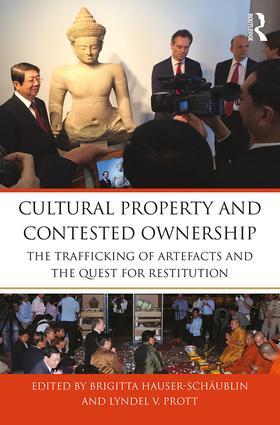
Zustellung: Di, 10.06. - Mo, 16.06.
Versand in 3-4 Wochen
VersandkostenfreiBestellen & in Filiale abholen:
Cultural artefacts, such as those kept and trafficked between art dealers, private collectors and museums, have increasingly become localized in a 'Bermuda triangle' of colonialism, looting and the art (black) market, with their re-emergence resulting in disputes about ownership and claims for return. Taking the 1970 UNESCO Convention on the Means of Prohibiting and Preventing the Illicit Import, Export and Transfer of Ownership of Cultural Property as a starting point, this book explores how highly valued cultural goods are traded and negotiated among diverging parties and their interests. Against the backdrop of international conventions and their implementation, individual cases are examined from a bottom-up perspective, with contributions from anthropologists, lawyers, historians and archaeologists.
Inhaltsverzeichnis
Introduction: changing concepts of ownership, culture and property.
Brigitta Hauser-Schäublin and Lyndel V. Prott
Part I: Plunder, trafficking and returnIntroduction
01) Destruction and plunder of Cambodian cultural heritage and their consequences.
Keiko Miura
02) Cambodia's struggle to protect its movable cultural property and Thailand.
Alper Tasdelen
03) Looted, trafficked, donated, and returned: the twisted tracks of Cambodian antiquities.
Brigitta Hauser-Schäublin
Part II: Between profit, authenticity and ethicsIntroduction
04) Struggles over historic shipwrecks in Indonesia: economic versus preservation interests.
Mai Lin Tjoa-Bonatz
05) Faked biographies. The remake of antiquities and their sale on the art market.
Brigitta Hauser-Schäublin and Sophorn Kim
Part III: Negotiating conditions of returnIntroduction
06) The Benin treasures: difficult legacy and contested heritage.
Barbara Plankensteiner
07) Pre-Columbian heritage in contestation. The implementation of the UNESCO 1970 convention on trial in Germany.
Anne Splettstößer
08) Return logistics - repatriation business. Managing the return of ancestral remains to New Zealand.
Sarah Fründt
Epilogue
Lyndel V. Prott
Brigitta Hauser-Schäublin and Lyndel V. Prott
Part I: Plunder, trafficking and returnIntroduction
01) Destruction and plunder of Cambodian cultural heritage and their consequences.
Keiko Miura
02) Cambodia's struggle to protect its movable cultural property and Thailand.
Alper Tasdelen
03) Looted, trafficked, donated, and returned: the twisted tracks of Cambodian antiquities.
Brigitta Hauser-Schäublin
Part II: Between profit, authenticity and ethicsIntroduction
04) Struggles over historic shipwrecks in Indonesia: economic versus preservation interests.
Mai Lin Tjoa-Bonatz
05) Faked biographies. The remake of antiquities and their sale on the art market.
Brigitta Hauser-Schäublin and Sophorn Kim
Part III: Negotiating conditions of returnIntroduction
06) The Benin treasures: difficult legacy and contested heritage.
Barbara Plankensteiner
07) Pre-Columbian heritage in contestation. The implementation of the UNESCO 1970 convention on trial in Germany.
Anne Splettstößer
08) Return logistics - repatriation business. Managing the return of ancestral remains to New Zealand.
Sarah Fründt
Epilogue
Lyndel V. Prott
Produktdetails
Erscheinungsdatum
04. Juli 2016
Sprache
englisch
Seitenanzahl
260
Herausgegeben von
Brigitta Hauser-Schäublin, Lyndel V Prott
Verlag/Hersteller
Produktart
gebunden
Gewicht
638 g
Größe (L/B/H)
238/164/20 mm
ISBN
9781138188839
Entdecken Sie mehr
Bewertungen
0 Bewertungen
Es wurden noch keine Bewertungen abgegeben. Schreiben Sie die erste Bewertung zu "Cultural Property and Contested Ownership" und helfen Sie damit anderen bei der Kaufentscheidung.










